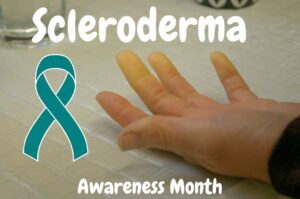Unlocking Understanding: Shedding Light on Scleroderma Awareness Month
Scleroderma Awareness Month, observed in June, serves as a beacon of enlightenment and empowerment for those grappling with this autoimmune condition. Amidst the sea of teal, a color symbolizing resilience and advocacy, this campaign ignites conversations, spreads knowledge, and fosters support networks. Let’s delve into the nuances of scleroderma – its definition, origins, manifestations, diagnostic journey, and avenues for management.
 |
| Scleroderma Awareness Month |
What is Scleroderma?
Scleroderma, a complex autoimmune disorder, unleashes a cascade of changes in the body, primarily affecting the skin but also infiltrating internal organs. This condition, characterized by abnormal tissue growth and immune system dysfunction, poses multifaceted challenges to those it touches.
When is Scleroderma Awareness Month?
June stands as the designated month to shine a spotlight on scleroderma. Within these thirty days, communities unite to bolster awareness, understanding, and support systems for individuals navigating the labyrinth of this condition.
What is the Color for Scleroderma?
Teal emerges as the emblematic hue for scleroderma awareness efforts. With June 29th marked as the pinnacle, teal ribbons flutter as symbols of solidarity, urging advancements in research, patient care, and societal comprehension.
Elevate awareness with our Scleroderma Awareness Month campaign t-shirt, adorned with symbolic teal hues. Join the movement, ignite conversations, and foster support!
|
|
| Scleroderma Awareness Month 2025 |
What Causes Scleroderma?
The precise triggers of scleroderma remain elusive, intertwining genetic predispositions with environmental factors. Dysregulation of the immune system prompts an aberrant response, leading to collagen overproduction and tissue hardening. While the exact genesis remains enigmatic, ongoing research endeavors strive to unravel the intricacies of this perplexing condition.
What are the First Signs of Scleroderma?
Scleroderma often unveils itself insidiously, with symptoms varying widely among individuals. Early warning signs may include Raynaud’s phenomenon – characterized by color changes in extremities upon exposure to cold or stress – along with skin tightening, joint stiffness, and digestive disturbances. Vigilance towards these subtle cues facilitates timely intervention and management.
How is Scleroderma Diagnosed?
Diagnosing scleroderma demands a comprehensive approach, amalgamating clinical evaluations, laboratory investigations, and imaging studies. Skin biopsies may unveil characteristic alterations, while pulmonary function tests and echocardiograms gauge internal organ involvement. A multidisciplinary team, comprising rheumatologists, dermatologists, and pulmonologists, collaborates to navigate the diagnostic odyssey with precision and compassion.
Scleroderma Symptoms
The symptomatology of scleroderma spans a vast spectrum, manifesting differently across affected individuals. From skin thickening and vascular complications to gastrointestinal dysfunction and pulmonary fibrosis, the ramifications of this condition permeate multiple organ systems. Navigating this labyrinthine landscape necessitates tailored management strategies tailored to individual needs.
Scleroderma Treatment
While a definitive cure remains elusive, an arsenal of treatment modalities exists to mitigate symptom burden and optimize quality of life. Pharmacotherapy, ranging from immunosuppressants to vasodilators, targets underlying pathogenic mechanisms. Physical therapy fosters mobility and functionality, while nutritional interventions alleviate gastrointestinal distress. Patient education and psychosocial support form integral pillars, empowering individuals to navigate the vicissitudes of scleroderma with resilience and grace.
Conclusion
As Scleroderma Awareness Month draws to a close, its reverberations endure, permeating hearts and minds with newfound understanding and empathy. In the face of adversity, solidarity prevails, transcending barriers and forging pathways towards healing and hope. Let us continue to champion the cause, advocating for progress, compassion, and inclusivity in the journey towards conquering scleroderma’s enigmatic grasp.

